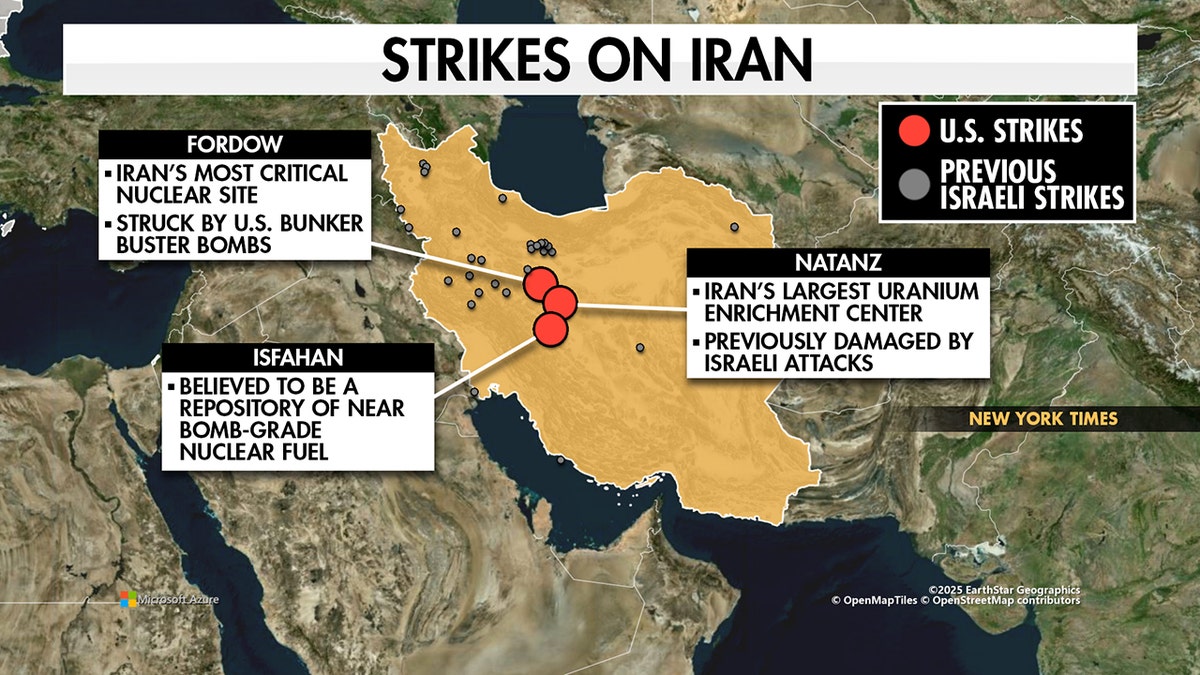Articles in this Cluster
26-06-2025
CNN’s Fred Pleitgen reports from inside a heavily damaged building in Tehran following an Israeli airstrike, detailing the extent of destruction and sharing testimony from a resident who witnessed the blast. The segment situates the strike within escalating regional tensions, amid ongoing claims and counterclaims about broader military actions involving Iran, Israel, and the U.S.
Entities: Iran, Israel, Tehran, CNN, Fred Pleitgen • Tone: analytical • Sentiment: negative • Intent: inform
26-06-2025
CNN’s Erin Burnett compares Iran’s underground Fordow nuclear facility to the Cheyenne Mountain Complex in Colorado, highlighting their shared design as hardened, bunker-like installations built inside mountains to resist attack. The segment examines structural similarities and strategic intent behind such fortified sites.
Entities: Fordow nuclear facility, Cheyenne Mountain Complex, Iran, Colorado, Erin Burnett • Tone: analytical • Sentiment: neutral • Intent: analyze
26-06-2025
An Israeli assessment says recent U.S. strikes severely damaged Iran’s nuclear program, destroying critical infrastructure at the Fordow enrichment site and rendering it inoperable, setting Iran’s nuclear weapons capability back “many years.” The assessment aligns with Iranian acknowledgments of serious damage. The June 22 strikes targeted Fordow, Natanz, and Isfahan, with B-2 bombers using 30,000-pound bunker busters on Fordow; Israel later hit access roads and other military targets. Iran says it is assessing damage and preparing to restore operations, while U.S. and Israeli leaders warn they will respond if Iran attempts to rebuild its nuclear program.
Entities: United States, Iran, Israel, Fordow enrichment site, Natanz • Tone: analytical • Sentiment: neutral • Intent: inform
26-06-2025
Maxar satellite images show significant damage at Iran’s Fordow, Natanz, and Isfahan nuclear sites following June 22, 2025 U.S. B-2 strikes ordered by President Trump. At Fordow, craters and destroyed perimeter buildings mark access roads and suspected tunnel entrances. Isfahan displays surface destruction and hits on tunnel portals, indicating an effort to neutralize buried infrastructure. Natanz shows two previously reported craters now filled and covered. IAEA chief Rafael Grossi confirmed key buildings and underground systems at all three sites were hit, with U.S. officials claiming Iran’s nuclear program was severely set back. Additional imagery shows widespread strike damage near Tehran’s Shahid Rajaee University linked to suspected nuclear-related facilities.
Entities: Iran, Fordow, Natanz, Isfahan, IAEA • Tone: analytical • Sentiment: neutral • Intent: inform
26-06-2025
U.S. and Israeli strikes inflicted significant damage on key parts of Iran’s nuclear infrastructure but did not eliminate the program. At Fordo, powerful U.S. “bunker buster” bombs sealed entrances and likely knocked centrifuges offline, though underground halls appear intact and potentially salvageable. Natanz suffered direct impacts to its shallow underground enrichment halls and destruction of aboveground facilities. At Isfahan, attacks destroyed the uranium conversion capability under construction, creating a major bottleneck that could take years to rebuild—unless Iran has a secret backup plant. Intelligence assessments differ: a leaked U.S. report says the program was set back only months, while U.S. officials and the IAEA confirm serious damage but stop short of declaring it “wiped out.” The fate and location of Iran’s stockpile of 60 percent enriched uranium remain unclear, with evidence some material was moved before the strikes. Iran may also be developing a deeper, more secure site near Natanz.
Entities: Iran’s nuclear program, United States, Israel, Fordo, Natanz • Tone: analytical • Sentiment: neutral • Intent: inform
26-06-2025
Analysts say the US B-2 strikes on Iranian nuclear sites underscore why China still needs dedicated strategic bombers despite advances in sixth‑generation fighters and long‑range missiles. The long‑range, stealthy bombers’ ability to conduct global conventional and nuclear missions—and to penetrate defended targets with heavy munitions—remains “irreplaceable.” With China’s H‑20 still in development, the operation highlights the role of strategic bombers in power projection and nuclear deterrence for major militaries.
Entities: United States, B-2 Spirit, Iran, China, H-20 • Tone: analytical • Sentiment: neutral • Intent: analyze
